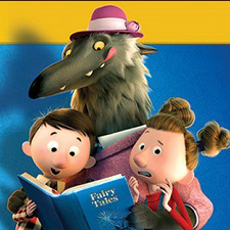
To help promote the latest entry in the wildly successful Shrek franchise, directors Chris Miller and Raman Hui recently engaged in separate discussions with Animated News & Views’ Josh Armstrong. In the conversations, Miller and Hui both provided insight into the making of Third, while also explaining how they each became involved with the picture. Furthermore, topics ranged from the involvement of Andrew Adamson, who helped helm the previous Shrek installments, to what folks might even expect from the movie’s future DVD release. Likewise, hints concerning the upcoming Shrek the Halls television special and Shrek Broadway show were also revealed.
Having graduated from the California Institute of the Arts’ Animation/Film department, Chris Miller has expressed his talents through a plethora of ways. He has collaborated with the Helios Dance Theater, creating sets, films and projections. Furthermore, Miller has helped develop numerous projects, including features, commercials, videos and internet projects. One such undertaking was a short for Steven Spielberg, titled Steven’s Dream. Meanwhile, Miller has worked on commercials for Coca-Cola, Canon, The Comedy Channel and FILA, with the latter ad resulting in a Clio Award for best animated commercial. In addition, he has also produced several independent animated projects, which have been featured via MTV and festivals in North America and Europe.
In 1998, Miller was hired by DreamWorks Animation, becoming a story artist on the studio’s first animated feature film, Antz (1998). Next, he served as a story artist on the Academy Award-winning blockbuster Shrek (2001), for which he also penned additional dialogue, and voiced Magic Mirror plus Geppetto. Miller’s work for the film led to his becoming head of story on Shrek 2 (2004), the highest-grossing animated film of all time. Along with the various voices he supplied for characters in the Shrek movies, he likewise gave Kowalski the penguin a voice in Madagascar (2005).
 Miller now makes his feature film directing debut with Shrek the Third (2007). Relieved, he admits that he is pleased with the sequel’s quality. “I’m happy to say that, especially having seen it, you know, some 400-500 times over the course of the last three years. The very last session we had with it, which was just mixing it – last chance to give notes, basically – I managed to enjoy it,” comments Miller. “And this may not sound impressive, but I did 25-30 minutes of it in a row, and I just sat down and went, ‘Oh, this is a cool film!’ You know, I just kind of got lost in it and enjoyed it.”
Miller now makes his feature film directing debut with Shrek the Third (2007). Relieved, he admits that he is pleased with the sequel’s quality. “I’m happy to say that, especially having seen it, you know, some 400-500 times over the course of the last three years. The very last session we had with it, which was just mixing it – last chance to give notes, basically – I managed to enjoy it,” comments Miller. “And this may not sound impressive, but I did 25-30 minutes of it in a row, and I just sat down and went, ‘Oh, this is a cool film!’ You know, I just kind of got lost in it and enjoyed it.”
Animated Views: How did you become involved with Shrek the Third?
 Chris Miller: Well, I had been in Shrek’s world since, gosh, like 1999 – since the first film, as a story artist. Then, I was head of story on the second movie. I’ve been around for a long time on it. Then, I was fortunate enough for them to offer me the directing role.
Chris Miller: Well, I had been in Shrek’s world since, gosh, like 1999 – since the first film, as a story artist. Then, I was head of story on the second movie. I’ve been around for a long time on it. Then, I was fortunate enough for them to offer me the directing role.
AV: Why was it decided for Shrek 3 to be renamed Shrek the Third?
CM: I think it was for a couple of reasons. The way we look at the series is just sort of as a continuous story. We didn’t want to just sort of title it like it was just a sequel. [We wanted] something to make it stand on its own, give it its own personality and really try to treat it as a chapter in Shrek’s life.
I quite like the name, because there were other iterations of it that just felt like the title for any sequel. I can’t even remember one of the ideas. It was one of those like, Shrek 3: The Blah Blah Blah, Blah Blah Blah. It sounded very generic and like something everyone’s heard a thousand times for a thousand different sequels. So Shrek the Third just sort of stuck.
AV: You can’t remember what the other titles were?
CM: I’ll tell you one of them. None of these came to be, but as an example of options: Shrek 3: King of the Swamp, I think, was an option or someone’s idea. I was like, ‘What?!’ ‘Well, you know, he’s a king – and he lives in a swamp.’ And I was like, ‘Oh, that’s really terrible…’ Thank goodness no one got behind that.
But you know, like that kind of stuff. We had to just work to come up with something that was fun and original.
 AV: To what extent was Andrew Adamson involved with Third?
AV: To what extent was Andrew Adamson involved with Third?
CM: Andrew’s involvement worked out great this time. He was executive producer, first of all. And you know, I’ve got a long history with Andrew. We’re good friends and worked on the first two films together. So we’re very familiar with each other and have very similar sensibilities.
But of course, Andrew was off directing Narnia and Prince Caspian, which he’s shooting right now. So he wasn’t around a lot. But we were always in contact. It worked out really great for us, because here we have this guy who knows the world and its characters so well, but he’s not there today. So we’d get together with him every four months or so, depending on the availability. Andrew could come in, and we’d show him the film in its current state, and he could see it with fresh eyes, something that he didn’t even have on the first two films. It was nice to kind of have that in our back pocket all the time. He could just look at the storytelling or something and go, ‘I think you guys are off here,’ and help us come up with solutions. I think he played, for me, a very important role.
AV: Could you describe any abandoned sequences or plotlines from the film?
CM: How much time do you have, really? I could probably describe to you four other versions of the movie.
AV: I think we only have about fifteen minutes!
 CM: [laughs] I mean, the one that immediately leaps to mind – this will probably be the somewhat long-winded version – but for a while, we had really expanded Arthur’s storyline. It was sort of the original hook concept, which was ‘Shrek reinvents the Arthurian legend.’ It was something the studio really got behind. And I was like, ‘Okay.’
CM: [laughs] I mean, the one that immediately leaps to mind – this will probably be the somewhat long-winded version – but for a while, we had really expanded Arthur’s storyline. It was sort of the original hook concept, which was ‘Shrek reinvents the Arthurian legend.’ It was something the studio really got behind. And I was like, ‘Okay.’
We went down that road, and the more we went down that road, we came up with great ideas – some great sequences, really entertaining, really funny. But there was just something fundamentally wrong with it. Then, after a while, you realize, ‘Oh, the problem here is, we’re not telling a Shrek movie. We’re telling an Arthur story, with Shrek supporting it.’ It was good, but it just wasn’t working.
So when we discovered that, we abandoned a lot of these scenes. We just made sure we were telling a Shrek story, with Arthur supporting it.
 But one of the scenes involved Arthur trying to woo Guinevere, at the high school. It was Shrek, Puss and Donkey in the bushes, giving love advice to Arthur as he’s below Guinevere’s balcony. It was great – three different perspectives on how to win over a woman. It was a hilarious scene and one of those things that breaks your heart to let go. We held on to it for a long time, because we liked it so much. But that was one of the things.
But one of the scenes involved Arthur trying to woo Guinevere, at the high school. It was Shrek, Puss and Donkey in the bushes, giving love advice to Arthur as he’s below Guinevere’s balcony. It was great – three different perspectives on how to win over a woman. It was a hilarious scene and one of those things that breaks your heart to let go. We held on to it for a long time, because we liked it so much. But that was one of the things.
There was a huge quest for Artie, at one point, when Shrek, Puss and Donkey were helping him win this contest against Lancelot. It just really expanded kind of longwinded Arthurian storylines.
They were great; they were some beautiful scenes. You’ll see them on the DVD. I’m sure they’ll all end up in the DVD extras. They won’t go entirely to waste.
 AV: Speaking of the story for Shrek the Third, what was the very beginning for the project? For instance, was it in development during Shrek 2?
AV: Speaking of the story for Shrek the Third, what was the very beginning for the project? For instance, was it in development during Shrek 2?
CM: At the time, I was so involved with Shrek 2 – you know, we were still finishing up. The movie came out in May 2004. And somebody was working on a third one. At that point, I wasn’t involved at all. I was just doing my job and finishing up the second one. But I read a script for Shrek 3 about nine months before Shrek 2 came out. So it was in 2003. I mean, they got a big jump on it.
So, yeah, I got that first draft of the script, which was great. I looked at it and went, ‘Mmm-hmm. Okay,’ and then very quickly just sort of tossed it aside, because it didn’t work. We just started from scratch that fall, which was fall 2003. So I was kind of doing double duty between Shrek 2 and Shrek 3. It was just sort of that early phase of outlining and coming up with ideas and characters. Then, we really started boarding the film and getting it going a couple of months before Shrek 2 came out. Here we are, three years later.
AV: When you say the script didn’t work, was that the one in which Arthur was the main character, or did that script have a totally different story?
CM: Yeah, that was a big part of the problem. Although at the time, I have to say that wasn’t so much the issue with the script. We did go down that Arthurian legend road I’d say a good year, trying to make it work, trying to get the sword in the stone involved, and the Lady of the Lake and these familiar Arthurian legends.
So that was part of the issue with that original script. But I think it just came down to, you know, sometimes it’s hard to describe exactly what makes a Shrek movie work and what doesn’t. A lot of times, we act on instinct, based on years of trial and error and understanding. The character can do this; the stories can do this. They can be this anachronistic, or they can’t. Sometimes, we don’t even know where the line is, but we know when we’ve crossed it.
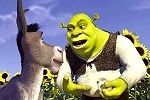 It was just one of those situations where, here was a screenplay that was – and it’s nothing against the writers of the screenplay. They just weren’t part of that process or that world. They were hired to do a job; they went off and did it. But we weren’t involved with them. And they came back with a script of what they thought a Shrek film would be. It just fundamentally didn’t feel right, and I can’t really describe why. But the character’s voices, situations, the choices that they would make – it felt like a caricature of a Shrek story instead of a real Shrek story.
It was just one of those situations where, here was a screenplay that was – and it’s nothing against the writers of the screenplay. They just weren’t part of that process or that world. They were hired to do a job; they went off and did it. But we weren’t involved with them. And they came back with a script of what they thought a Shrek film would be. It just fundamentally didn’t feel right, and I can’t really describe why. But the character’s voices, situations, the choices that they would make – it felt like a caricature of a Shrek story instead of a real Shrek story.
It’s the way feature animation works. You’ve got to try stuff over and over again, and workshop it and rework it to really find the tone and to create the right kind of situations. I think it’s the same for all of them. It takes a long time. It’s a good two solid years of story and throwing stuff out and the willingness to try things over and over again. I mean, we were on the story for Shrek the Third up until about two or three months ago, always refining it.
AV: What would you say was the most challenging aspect of directing Shrek the Third?
 CM: You know, I’m biased, because I come from the story-writing end of things. But I really feel like that’s the biggest challenge, and not just for Shrek the Third but for any film. For me, it always comes down to the believability of a story and the quality of the content and the characters. You can have the most dazzling-looking film – you know, technologically advanced, fantastic cinematography, art direction, production design – which I think, fortunately, we do on this film. I really think it operates at such a high level. But if it’s not there to support the story, and you’re just not buying the story, then I don’t care what film it is, it won’t work.
CM: You know, I’m biased, because I come from the story-writing end of things. But I really feel like that’s the biggest challenge, and not just for Shrek the Third but for any film. For me, it always comes down to the believability of a story and the quality of the content and the characters. You can have the most dazzling-looking film – you know, technologically advanced, fantastic cinematography, art direction, production design – which I think, fortunately, we do on this film. I really think it operates at such a high level. But if it’s not there to support the story, and you’re just not buying the story, then I don’t care what film it is, it won’t work.
So it’s always the story. It takes the longest; it’s the hardest thing. And with us, we’ve got a lot of talented people – really funny and interesting – and so it’s always fairly easy for us to come up with situations or gags or entertainment. But the stuff, I think, that makes any of the Shrek films work is the emotional, dramatic side of the story. It really has to feel real, in order for the film to function.
AV: Looking at the film now, is there anything you wish you had done differently?
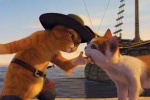 CM: Fundamentally? I would say, no. I’m very grateful to be able to say this. There’s nothing about the story that I feel like, ‘Oh! I wish we had we done that differently,’ or, ‘I think we made a bad choice here or there.’
CM: Fundamentally? I would say, no. I’m very grateful to be able to say this. There’s nothing about the story that I feel like, ‘Oh! I wish we had we done that differently,’ or, ‘I think we made a bad choice here or there.’
There are always a thousand things I could change or want to change. But fortunately, it feels strong to me. When it comes to animation – and I think the animation is great in the film – but you always wish you had more time. You always wish you had more time to just refine performance, even just a little bit more. But I think no matter what film I worked on, I would always feel that way.
Actually, I think the animation is really the best of the three films. The performance is the most subtle. Technology – I mean, that’s the biggest leap in technology too, with the facial system and the tools the animators were given to make these really subtle performances.
AV: How do you decide which actors would best suite certain roles?
 CM: It’s pretty simple, really. Usually – and we’re kind of blessed in this way – we can sit down – myself and [Aron] Warner, the producer – and sit there and just make a wish list of who we would we like to work with, who do we respect, who do we think is great. We write our list together and find the roles for them. Fortunately, nine times out of ten, they say, ‘Yes.’
CM: It’s pretty simple, really. Usually – and we’re kind of blessed in this way – we can sit down – myself and [Aron] Warner, the producer – and sit there and just make a wish list of who we would we like to work with, who do we respect, who do we think is great. We write our list together and find the roles for them. Fortunately, nine times out of ten, they say, ‘Yes.’
There are enough great actors and actresses out there that want to work on these films. It kind of comes down to, ‘What’s your dream wish list?’ It’s amazing they said, ‘Yes.’
AV: What are some of the inside jokes or references that folks can look for, in Shrek the Third?
CM: Inside jokes? What do you mean, like…?
AV: A lot of people say Shrek nods toward Disney. But I also mean any kind of joke, whether it’s toward an animator or anything like that.
CM: It’s hard to say. I’m not sure. Honestly. I would say this, never consciously have we ever gone out to take a dig at Disney in any scene, like, ‘Let’s try to create an inside joke.’ I would say the comedy just tends to come from just a personal point of view or experience.
For instance, when it comes to the princesses in the new film, they’ve all been represented in a Disney film from our youth. We just wanted to create kind of a different take on those characters, other than what we saw when we were growing up.
To me, like the Snow White from the Disney film, which is fantastic. It’s a landmark, brilliant movie. But she was this very sweet, pure character. There was a certain perfection to Snow White. I think we said, ‘Well, let’s create a character that we just want to hang out with or find interesting.’ So we went the opposite way. We just tried to deconstruct her a bit and put a contemporary spin on her. Instead of being pure and sweet, she’s actually the one with the strongest sense of entitlement. Probably the most conceited, because she was called ‘The fairest of them all,’ and she believes they’re impressed. She’s quick to point that out with everyone else, because she’s pretty competitive with the other princesses.
That’s all we do. We just try to create something that makes us laugh, and we find interesting.
AV: What are some things people can anticipate for the upcoming DVD? Well, I say upcoming…
CM: Oh, but it’s true! It’s a completely reasonable question, in this day and age. It’s like, ‘The movie comes out on Friday, and the DVD comes out on Tuesday!’
What are the extras… Well, I know there’s going to be, like we were talking about before, a few scenes that didn’t make the movie, in storyboard form. Above and beyond that, I wish I could tell you, but I don’t know.
 My head has been so buried in getting the film done, that’s just sort of this peripheral thing going on. But I know [the amount of extras] is a lot, like a ton of bonus material, this time around. But we’ll both be surprised together.
My head has been so buried in getting the film done, that’s just sort of this peripheral thing going on. But I know [the amount of extras] is a lot, like a ton of bonus material, this time around. But we’ll both be surprised together.
Here’s the good news: I can really describe no content, but I would say this time around, more than the previous two, is that sort of that core group of story artists – which, to me, I mean, they really take the lead on a lot of the writing and creating and conceptualizing, they’re just an essential part of it – they all contributed in a much bigger way to the DVD extras, this time around.
So I really feel the quality of the content is going to be far greater than it’s ever been. Usually, the folks putting together DVDs are from a different department. They’re not necessarily associated with the movie. This time around, it was very important that they were. It makes a huge difference. They get the Shrek world; they get the Shrek talent, and they put all those efforts in.
AV: Have you been involved with Shrek the Halls?
CM: Very little. In terms of writing and conceptualizing, not at all. But I helped them out with voice recording sessions, because a lot of times, we were crossing over. We were recording Shrek the Third simultaneously. So I helped out with directing those sessions.
 AV: Can you give us an idea of what characters or other elements from Shrek the Third will appear in Shrek the Halls?
AV: Can you give us an idea of what characters or other elements from Shrek the Third will appear in Shrek the Halls?
CM: I’d say this: in the Shrek world, everything is continuous. So Shrek the Halls will basically pick up where Shrek the Third leaves off.
It’s all the familiar fairy tale faces that you’ve seen. Everyone is in the film. It’s sort of Shrek’s first Christmas, and something that’s entirely foreign to him – you know, a family Christmas and what that means and trying to deal with that sort of situation.
AV: Regarding another future Shrek project, the Broadway musical, I’ve read that it will include parts of the first two Shrek films. Will it also include some of the third one?
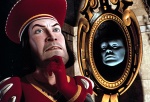 CM: I don’t know. I was the Magic Mirror in the first movie, and no one’s called me. I could sing, so it’s wildly disappointing! I will have no side Broadway project appearance!! The only thing I’ve heard, the producer is more involved. He’s more of a consultant on it. I’m always the guy going, ‘Ooh! Can I come to rehearsal or come check out something?!’ And they’re like, ‘Yes, Chris. Sure.’ And then I never get called!
CM: I don’t know. I was the Magic Mirror in the first movie, and no one’s called me. I could sing, so it’s wildly disappointing! I will have no side Broadway project appearance!! The only thing I’ve heard, the producer is more involved. He’s more of a consultant on it. I’m always the guy going, ‘Ooh! Can I come to rehearsal or come check out something?!’ And they’re like, ‘Yes, Chris. Sure.’ And then I never get called!
But he’s told me that he’s amazed with the show. [He is] someone who generally doesn’t like Broadway stuff, and he’s just like, ‘It’s amazing!’
It’s a completely new take on the Shrek story. It’s realized in an amazing way. He’s incredibly positive about it.
AV: When you say producer, are you referring to Aron Warner?
CM: Yeah. He’s very impressed with it. Once again, we’ll be surprised together! That is all secondhand info.
AV: Could you provide any details on your upcoming projects? Are you going to continue with the Shrek universe or branch off?
CM: My immediate project is called ‘vacation.’ I’m going to take some time off. If I’m involved with Shrek 4, I’m not sure yet. I’ve just been so wrapped up in this movie, in getting it finished, that I haven’t even really had discussions about it.
They’re in that early phase right now, searching for ideas and coming up with a good concept. We’ll see. I just sort of plan on laying low, until the end of summer, and then coming back. I certainly owe DreamWorks another picture, which I’m happy about. We’ll see what it will be.
AV: What advice would you like to offer anyone hoping to work in the animation industry?
CM: In any capacity? Actually, I went in as an animator and learned quickly that I wasn’t very good! I always loved animation and ended up gravitating toward writing and storytelling.
What I would offer – I don’t know if this is really advice – but what I would love to see is feature animation not even referred to as ‘feature animation,’ in the near future. Just refer to it as a film, as filmmaking. That being said, I would love to see filmmakers enter animation as a filmmaker and, especially for American animation, push it into other genres and understand that you’re not making an ‘animated feature,’ you’re just making a film.
 I would love to see a horror film in animation, or a thriller. But just push the art form into different genres and open it up. I think that time is coming. I think it’s long overdue. I think, especially in CG, as we push closer and closer to something that feels more realistic or the possibility of even photorealism, if it is going that way, the art form can open up and become much more than it is right now, because animation is not a genre. It’s a tool; it’s a technique.
I would love to see a horror film in animation, or a thriller. But just push the art form into different genres and open it up. I think that time is coming. I think it’s long overdue. I think, especially in CG, as we push closer and closer to something that feels more realistic or the possibility of even photorealism, if it is going that way, the art form can open up and become much more than it is right now, because animation is not a genre. It’s a tool; it’s a technique.
It’s not really advice. But I would just love to see that quality of filmmaking enter, something more along the lines of what you see coming out of Japan.
To help Miller craft Shrek the Third, Raman Hui was added to the project as co-director. At Quantum Studio, in Hong Kong, Hui began his career in animation working as a cel animator. He later studied computer animation at Sheridan College, in Canada. In the past decade, Hui has assisted in computer-generating such characters as Mickey Mouse for Jim Henson’s Muppetvision, the first CG Pillsbury Doughboy, and a helmeted Martian who interacts with a live-action earthling for Hanna-Barbera’s television special The Last Halloween.
Since 1989, Hui has been with PDI/DreamWorks. During his time with the company, Hui’s leadership skills have been witnessed by teams developing commercials, shorts and feature films. For instance, he directed, wrote and produced the PDI/DreamWorks short Sleepy Guy (1994), which received awards at the London Animation Festival and the US International Film & Video Festival, while also winning first place at Imagina in 1995. Hui’s most recent in-house short, Fat Cat on a Diet (2000), was screened at an abundance of festivals and conferences, including the London Effects and Animation Festival (LEAF), Anima Mundi and the Chicago International Children’s Film Festival.
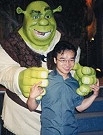 In the meantime, Hui was lead character designer/supervising animator on PDI/DreamWorks’ Antz (1998). Subsequent work for Hui involved his serving as supervising animator on Shrek (2001) and a follow-up for Universal Studios’ theme park attraction Shrek 4-D (2003). Similarly, he was one of the supervising animators for Shrek 2 (2004). Hui was also director of animation on DreamWorks Television & NBC’s primetime animated comedy series Father of the Pride (2004).
In the meantime, Hui was lead character designer/supervising animator on PDI/DreamWorks’ Antz (1998). Subsequent work for Hui involved his serving as supervising animator on Shrek (2001) and a follow-up for Universal Studios’ theme park attraction Shrek 4-D (2003). Similarly, he was one of the supervising animators for Shrek 2 (2004). Hui was also director of animation on DreamWorks Television & NBC’s primetime animated comedy series Father of the Pride (2004).
Following his work for that show, Hui moved on to Shrek the Third (2007). Recalling his time with the project, he seems very pleased at the experience. “It’s been a great pleasure for me to work on this film with Chris Miller and Aron Warner. I mean, they have taught me so much,” expresses Hui. “Also, we have a crew here – some of them have been working for the Shrek franchise since 1998, the first one. They know so much about the show and all the characters and the environments, it’s a blast for me to be able to work with them. It has been a lot of fun. ”
AV: How did you become involved with Shrek the Third?
 Raman Hui: I became involved with Shrek, I think, in 1998. I worked on first Shrek and then also Shrek 2. My job was supervising animator on the first one and then one of the supervising animators on the second one.
Raman Hui: I became involved with Shrek, I think, in 1998. I worked on first Shrek and then also Shrek 2. My job was supervising animator on the first one and then one of the supervising animators on the second one.
This time, I got a really good offer to be a co-director on the movie. I started around maybe three years ago. Actually, at that time, Chris Miller and Aron Warner had started on the movie already. I had just finished Father of the Pride, the TV show that DreamWorks did. After that, I started working on Shrek the Third, as co-director. Jeffrey Katzenberg was so nice to offer me the job.
AV: About the title Shrek the Third, why was that name chosen instead of Shrek 3?
RH: I guess because we didn’t want to just use the number, but at the same time, this is the third movie. We’d been calling it Shrek 3 for a long time, until DreamWorks came up with the idea of naming it Shrek the Third. It’s about Shrek becoming the new king of Far Far Away; the title sounds kind of royal as well. So it seems that it worked great with the story.
AV: To what extent was Andrew Adamson involved with Shrek the Third?
 RH: He’s one of our executive producers, so he was very involved, especially at the very beginning, because he came up with the basic idea of the story for this movie. Once every few months, we’d show him the work-in-progress of the whole movie, in story reel, and we’d get his notes. Sometimes, we might even send him pages of script, and he would give us notes as well.
RH: He’s one of our executive producers, so he was very involved, especially at the very beginning, because he came up with the basic idea of the story for this movie. Once every few months, we’d show him the work-in-progress of the whole movie, in story reel, and we’d get his notes. Sometimes, we might even send him pages of script, and he would give us notes as well.
He’s great. I mean, he’s so helpful, and he knows the characters and story so well. Also, both Chris and I, and Aron, have been working with him for so long that it’s very easy to work with him.
AV: What were some of the changes made to its story as the film’s production moved along?
RH: Actually, we have quite a few sequences that were in production, which we finished animation on. At the end, they didn’t make it to the movie, because the process of making the story is so organic, the film was changing all the time.
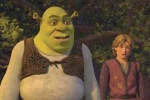 There was one sequence of Artie in high school. We actually went through animation, but at the end, we cut it out, because it slowed down the story. It also made the story too much about Artie instead of Shrek – and that’s our focus, we have to make sure that this is a Shrek movie, and it’s about Shrek. Artie, the new character that Justin Timberlake plays, is there to help tell the story of Shrek. So we just have to make sure that our focus stays focused.
There was one sequence of Artie in high school. We actually went through animation, but at the end, we cut it out, because it slowed down the story. It also made the story too much about Artie instead of Shrek – and that’s our focus, we have to make sure that this is a Shrek movie, and it’s about Shrek. Artie, the new character that Justin Timberlake plays, is there to help tell the story of Shrek. So we just have to make sure that our focus stays focused.
AV: Could you elaborate more on some of the scenes that were cut from Shrek the Third?
RH: Artie – he’s in love with Guinevere. At one point, we had Shrek, Puss and Donkey to help him get her attention. Puss is trying to sing some love song, in the background, and Donkey is dancing around to help Artie get her attention. That got cut, again, because it became too much of Artie’s story instead of Shrek.
AV: You mentioned Justin Timberlake as Artie. When you were casting, how was it decided which actors would best suite certain roles?
 RH: Well, we make that decision by listening to their voices. Like, we listened to Justin Timberlake’s acting actually from Saturday Night Live. He did some sketches, and he was so funny, and his acting was so good as well.
RH: Well, we make that decision by listening to their voices. Like, we listened to Justin Timberlake’s acting actually from Saturday Night Live. He did some sketches, and he was so funny, and his acting was so good as well.
Then, when we listened to his voice, it sounded very natural to have that voice play against Mike Myers, Eddie Murphy and Antonio Banderas. Also, it fit the character very well, because when you’re just listening to his voice, you totally believe that he’s just a teenager. That’s our character, Artie – he’s about 16 or 17 years old. That just fit very well.
We also did a little test of animating to his voice, using the character that we had decided already, at that time. They just matched so perfectly.
AV: What would you say were some of the most challenging aspects of directing Shrek the Third?
 RH: I think with this one, the most challenging aspect is the number of characters we have in this movie. We have all the fairy tale creatures. We also have all the fairy tale villains. Also, we have a lot of new characters like Artie, Merlin and all the princesses, like Snow White, Rapunzel, Cinderella and Sleeping Beauty. Just to make sure that all the characters have their own personality, and also to get all this done within the time we have, that’s very challenging.
RH: I think with this one, the most challenging aspect is the number of characters we have in this movie. We have all the fairy tale creatures. We also have all the fairy tale villains. Also, we have a lot of new characters like Artie, Merlin and all the princesses, like Snow White, Rapunzel, Cinderella and Sleeping Beauty. Just to make sure that all the characters have their own personality, and also to get all this done within the time we have, that’s very challenging.
It’s a lot of work for the animators. Sometimes, it’s not just animating one or two characters in the scene, they also have to animate all the background characters. So it’s really time-consuming as well.
AV: Could you explain some inside jokes, references or even tributes that audiences might find in the film?
RH: Let me think about that one! Like, stuff the audience might not know if I don’t point it out?
AV: Yes, for instance, subtle jokes.
 RH: Subtle jokes! Okay. In part of the story, Puss and Donkey switch bodies, because of some screwed-up magic. So Donkey – you see Eddie Murphy’s voice in the cat’s body, and then, Antonio Banderas’ voice in the Donkey’s body. There’s one part – this might be very confusing, the way I’m trying to explain this! So the cat, which is Donkey now – they’re trying to rescue Gingerbread Man. And remember in Shrek 2, when Puss was trying to steal the potion from Fairy Godmother? He gets up on top of the bookcase and cuts the glass with a perfect circle. So Donkey, as Puss now, is trying to do the same thing, but instead of cutting a perfect circle, he has trouble even drawing a straight line. So it’s all crooked, and he is doing it very slowly.
RH: Subtle jokes! Okay. In part of the story, Puss and Donkey switch bodies, because of some screwed-up magic. So Donkey – you see Eddie Murphy’s voice in the cat’s body, and then, Antonio Banderas’ voice in the Donkey’s body. There’s one part – this might be very confusing, the way I’m trying to explain this! So the cat, which is Donkey now – they’re trying to rescue Gingerbread Man. And remember in Shrek 2, when Puss was trying to steal the potion from Fairy Godmother? He gets up on top of the bookcase and cuts the glass with a perfect circle. So Donkey, as Puss now, is trying to do the same thing, but instead of cutting a perfect circle, he has trouble even drawing a straight line. So it’s all crooked, and he is doing it very slowly.
I don’t think all the audience might get that. But it’s kind of like a tribute to the second movie. I think the die-hard Shrek fans can catch that.
AV: Can you think of any other jokes?
 RH: There a lot of little jokes here and there. I think you might want to find them when you watch the movie. Like, the Queen [Lillian] is really funny. At one point in the movie, she starts singing, and that’s kind of a tribute to Julie Andrews than to other movies. But she’s just perfect, because that is her song.
RH: There a lot of little jokes here and there. I think you might want to find them when you watch the movie. Like, the Queen [Lillian] is really funny. At one point in the movie, she starts singing, and that’s kind of a tribute to Julie Andrews than to other movies. But she’s just perfect, because that is her song.
Also, we have – let me think… If I say too much, it’s like giving the jokes away…
AV: Understood! How about the eventual DVD…can you hint at some things we can anticipate for Shrek the Third?
RH: We are still working on it right now. I don’t even know what we are going to be putting on the DVD! Like I mentioned earlier, we’ve done a lot of sequences that got cut out when we were making the movie, at the end. Hopefully, those sequences that got cut, we’ll put them on the DVD. I don’t know what else we are planning on doing. I think it’s still too early to tell right now.
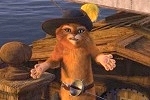 AV: Looking at the film, is there anything you wish you might have done differently?
AV: Looking at the film, is there anything you wish you might have done differently?
RH: Well, I don’t think so. If we have time, we always can go back to fine-tune the lighting, fine-tune the animation. But to some point, we have to say, ‘Okay, this is good enough,’ because it’s more important to have the whole movie done than make, say, one or two sequences really, really good.
But I think we did a really good job at making the movie very consistent and also consistently good. The standard of animation is really high, and I think we are very consistent with this movie. So I don’t think there is anything that we wish we could go back and change. But if we had a few more months, we probably would fine-tune whatever we have right now and make it even better.
AV: What elements introduced in Shrek the Third, such as characters, might appear in Shrek the Halls? For instance, will the new Princesses be in it?
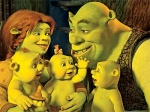 RH: Some new characters that will appear in Shrek the Halls as well are the babies. The babies are really fun, and we get to know them better too. At first, we don’t know which one is the girl baby, which one is the boy baby. But now, they all seem to start growing their personalities. They’re not the little babies we know a year ago any more. We don’t have names for them yet. But we can tell they’re starting to show different personalities.
RH: Some new characters that will appear in Shrek the Halls as well are the babies. The babies are really fun, and we get to know them better too. At first, we don’t know which one is the girl baby, which one is the boy baby. But now, they all seem to start growing their personalities. They’re not the little babies we know a year ago any more. We don’t have names for them yet. But we can tell they’re starting to show different personalities.
It’s kind of weird, because it’s so organic, you feel that they are actually getting a little bit older or getting a little bit bigger. They’re starting to show more emotion.
AV: Can you give us some more details as to what the special is about?
RH: It’s about Shrek’s first Christmas. Shrek never had a Christmas before. So this is the first time he is trying to have a Christmas with his whole family. It’s pretty funny, because you have Donkey, Puss and everyone else telling Shrek what to do, and they all are experts on what Christmas is about. It’s a very sweet half-hour special that has a lot Christmas spirit in it.
AV: How are you involved with Shrek the Halls?
 RH: Actually, I’m working on it today. I’m not doing much on that one. I’m just kind of hands-on, doing animation. Because the animators helped us on Shrek the Third until the end, we kind of pushed the schedule of Shrek the Halls a little bit. Now, for me to pay back, I have to help on animating. It’s been fun. Like today, I’m animating some of the baby for that special.
RH: Actually, I’m working on it today. I’m not doing much on that one. I’m just kind of hands-on, doing animation. Because the animators helped us on Shrek the Third until the end, we kind of pushed the schedule of Shrek the Halls a little bit. Now, for me to pay back, I have to help on animating. It’s been fun. Like today, I’m animating some of the baby for that special.
AV: Regarding the upcoming Shrek Broadway show, it’s been said that it will include parts of the first two Shrek films. Will it also include some of the third movie?
RH: I don’t know much about that. That’s all done in New York, and it’s a totally different thing. I mean, we send them a lot of references from our movies. But besides that, I have no idea what the show is about, or what kind of songs they are writing or performing.
AV: Okay, so what about your next project? Will you continue with the Shrek franchise?
RH: That, I don’t know. My next project is a vacation! I’m going to be helping out with Shrek the Halls for another month. Then, after that, I’m going to take some time off. I’ll figure out what I’m going to do after that.
AV: What advice would you like to offer anyone wanting to work in the animation industry?
RH: I think the animation industry is getting so big now. We used to just have Disney making animated features. Now, we have Disney together with Pixar, and then, we also have DreamWorks. Sony Pictures is producing a lot of animated movies as well. So actually, there are a lot of opportunities.
The tough part of that is, to get into any of the big studios, you just have to make sure that you have really good, high-quality work. It’s really important to show people that you can achieve something really good. So it’s more about the quality of the work than the quantity. If you have something short but impressive, people are going to remember that.
Also, there are a lot of schools where you can learn animation. They all have really high-end equipment that you can learn from. I think that’s really good.
Animated News & Views expresses special thanks to Chris Miller and Raman Hui, for kindly participating in these conversations. We likewise appreciate Olivier Mouroux for arranging the interviews. With that said, Josh Armstrong would like to personally thank his Animated News & Views colleague Ben Simon for his assistance in the editing of this piece.





